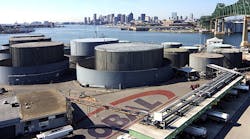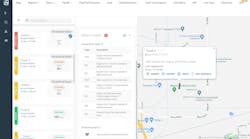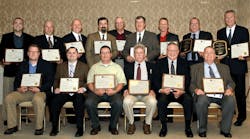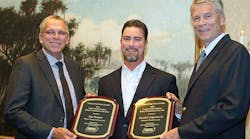THE Federal Motor Carrier Safety Administration recently announced significant changes to the Hazardous Materials Safety Permit (HMSP) program and published a Notice of Change in Enforcement Policy in the Federal Register.
Paul Bomgardner, chief of the Hazardous Materials Division in FMCSA’s Office of Enforcement and Compliance, discussed the changes during the National Tank Truck Carriers Tank Truck Safety & Security Council Annual Meeting June 9-11 in New Orleans, Louisiana. He said the changes are being accomplished through the Interpretive Rule, with FMCSA interpreting its regulations through a notice in the Federal Register.
For companies just coming into HMSP and making their initial application, nothing will change. They will still be held to the standards in 49 CFR 385.421 that deal with out-of-service and crash rates.
“The change will come after the issuance of the hazmat permit,” he said. “Today, if a carrier applies for a permit, the permit can be issued right then and there because they have a satisfactory safety rating, the out-of-service rates are OK, and they have the right level of insurance. It would almost be a seamless transition into the continuous monitoring program that will take place after a permit.
“The other thing that could happen is a carrier doesn’t have a satisfactory safety rating. Maybe they’ve never been rated. Maybe they’re one of the carriers that has been in business for 20 or 25 years and we’ve never come to look at them. They would get a temporary permit and still operate under the present rules. But once they got a satisfactory safety rating, the temporary goes to permanent status and they go into continuous monitoring or enhanced monitoring.”
“Once you have permanent status, it’s all based on Safety Measurement System (SMS) scores. We’re not saying that once you meet certain criteria, your hazmat safety permit gets revoked or suspended. Basically, it kicks in at intervention, and that is the scheduling of a comprehensive compliance review. We’re tying the suspensions and revocations and monitoring to 49 CFR 385.421. There are 10 criteria in there that will suspend or revoke your hazmat safety permit—anywhere from not having a satisfactory safety rating to not having the proper level of insurance.
“But there is one paragraph in there that talks about if your safety data shows you are not complying with FMCSA regulations, hazardous material regulations, or state and local regulations to the point where we feel you should not have this hazmat safety permit. That is the section we’re using to base monitoring on. All your violations go with SM. It gives us a reason to go out and take a better look at that carrier on a continuous basis, because right now, the only time we look at a safety record is every two years when you reapply for it, and we only go back a year. So you could be terrible for a year, clean up your act, come back in, and your out-of-service rates go down, and you could come back and get your hazmat safety permit. The new way will give us a better oversight over those carriers.”
HMSP improvements:
• HMSP carriers will still remain in SMS HM Threshold.
• Basic rules for interventions and investigations will continue to apply to HMSP carriers.
• Three Enhanced Oversight Conditions are added: HM BASIC over threshold for the two most recent months; two or more BASICs, other than HM for the two most recent months); or 48 months of insufficient data (NO BASICS scored for the entire time AND a safety rating four years or older).
“For the first two, we have 10 carriers out of 1,400 that meet those conditions,” he said. “We have 150 that meet the third condition. We have 150 carriers that we basically have not seen for four years. Some of their safety ratings go back to 1992. That last group is one we’re going to be taking a look at it. Most of them are small carriers. A lot of them are explosive carriers that are blasters or pyrotechnics companies. They aren’t big, over-the-road guys.”
He said the “new and improved” Hazardous Materials Route Registry was published in the Federal Register on April 29.
The Registry was reformatted for easier identification of routes: routes are now “route-ordered” and route-order maps are included in the docket.
MAP-21 requirements were incorporated in the Federal Register on October 2, 2014. States need to provide information on routing agencies and routing at least every two years, or when routes are added, amended or deleted. FMCSA needs to acknowledge states of receipt and publish information in Federal Register, and needs to publish route in HM Route Registry, which makes the route official.
Talking about cargo tanks and CT facilities, he said there are 4500 CT manufacturing, inspection and repair facilities, and of 20,500 bulk hazardous materials carriers, 7,000 are identified as CT in SMS.
Examples of CT facility incidents:
• January 21, 2014: Sully, Iowa. An individual at a truck wash in Sully died after being discovered unconscious inside of a tank trailer. Two other employees were found unconscious inside of the tank.
• May 6, 2014: Corona, California. An explosion at a Southern California trucking company killed one man and sent another to the hospital. It appears the explosion occurred while a welder was working on a petroleum tanker truck.
• July 27, 2013: Hammond, Indiana. It appears a fire was sparked when a two-man crew was working on a tanker inside a maintenance shop that simply no longer exists. One worker injured his back as he tried to escape the flames.
• July 24, 2013, Bridgeport, Texas. One man died after a tanker truck exploded, apparently set off by a spark from welding equipment that ignited a small amount of gas in the tanker that the 49-year-old male victim was working on.
Examples of Cargo Tank Safety Notices:
• Bench Testing of Pressure Relief Devices (PRDs).
• Important Notice Regarding Anhydrous Ammonia and Liquefied Petroleum Gas Hoses.
• Important Notice Regarding Trinity Manufactured MC 331 Tanks (Revised).
• Nurse Tank Safety Advisory.
• Classification and Package Selection of Hazardous Materials.
• Attachment of Appurtenances to MC-331 Cargo Tanks.
• Welded Repairs on Nurse Tanks.
• Cargo Tank Failure in Charleston, West Virginia.
• Safety Advisory: Unauthorized Cargo Tanks Used to Transport Hazardous Materials.
• Shipping Names and ID Numbers Authorized by Final Rule HM-218D.
• Tank Check 2004 Report.
He said FMCSA is focusing on the transportation of energy products by:
• More oversight of cargo tank motor carriers in crude oil and propane service.
• More oversight of cargo tank inspection and repair facilities servicing motor carriers in oil field operations.
• Advanced training of FMCSA investigators.
• Cooperative enforcement efforts with other federal and state agencies.
• Grants to states.
• Traffic enforcement.
• Outreach to the industry. ♦









![Alan Roberts [left], Wynne Transport Service Inc safety director accepts a plaque naming him Tank Truck Safety Professional of the Year for fleets under 15 million miles and David Edgerton [right] receives a plaque honoring him as Tank Truck Safety Professional of the Year for fleets above 15 million miles. The awards were sponsored by Heil Trailer International and were presented by Troy Hradsky with Heil Trailer International. Alan Roberts [left], Wynne Transport Service Inc safety director accepts a plaque naming him Tank Truck Safety Professional of the Year for fleets under 15 million miles and David Edgerton [right] receives a plaque honoring him as Tank Truck Safety Professional of the Year for fleets above 15 million miles. The awards were sponsored by Heil Trailer International and were presented by Troy Hradsky with Heil Trailer International.](https://img.bulktransporter.com/files/base/ebm/bulktransporter/image/2019/04/bulktransporter_1011_nttc_2015_safety_wynne.png?auto=format,compress&fit=crop&q=45&h=139&height=139&w=250&width=250)

